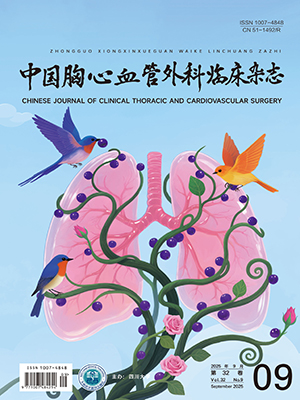| 1. |
中华医学会心血管病学分会心血管影像学组, 北京医学会心血管病学会影像学组. 中国成人心脏瓣膜病超声心动图规范化检查专家共识. 中国循环杂志, 2021, 36(2): 109-125.Division of Cardiovascular Imaging, Chinese Society of Cardiology, Chinese Medical Association, Imaging Group, Cardiovascular Department, Beijing Medical Association. Expert consensus for standard assessment by echocardiography in Chinese adults with valvular heart disease. Chin Circ J, 2021, 36(2): 109-125.
|
| 2. |
Yang Y, Wang Z, Chen Z, et al. Current status and etiology of valvular heart disease in China: A population-based survey. BMC Cardiovasc Disord, 2021, 21(1): 339.
|
| 3. |
Nkomo VT, Gardin JM, Skelton TN, et al. Burden of valvular heart diseases: A population-based study. Lancet, 2006, 368(9540): 1005-1011.
|
| 4. |
Lin J, Yang D, Zhao X, et al. The action logic of the older adults about health-seeking in south rural China. BMC Public Health, 2023, 23(1): 2487.
|
| 5. |
Xu H, Liu Q, Cao K, et al. Distribution, characteristics, and management of older patients with valvular heart disease in China: China-DVD study. JACC Asia, 2022, 2(3): 354-365.
|
| 6. |
Cheng TO. How much of the recent decline in rheumatic heart disease in China can be explained by changes in cardiovascular risk factors? Int J Cardiol, 2009, 132(3): 300-302.
|
| 7. |
Otto CM, Nishimura RA, Bonow RO, et al. 2020 ACC/AHA guideline for the management of patients with valvular heart disease: A report of the American College of Cardiology/American Heart Association Joint Committee on Clinical Practice Guidelines. Circulation, 2021, 143(5): e72-e227.
|
| 8. |
Mengi S, Januzzi JL, Cavalcante JL, et al. Aortic stenosis, heart failure, and aortic valve replacement. JAMA Cardiol, 2024, 9(12): 1159-1168.
|
| 9. |
Wang Y, Cao T, Liu X, et al. A new benchmark for modern management of valvular heart disease: The whole-life cycle management system. JACC Asia, 2025, 5(5): 609-632.
|
| 10. |
Gaede L, Di Bartolomeo R, van der Kley F, et al. Aortic valve stenosis: What do people know? A heart valve disease awareness survey of over 8, 800 people aged 60 or over. EuroIntervention, 2016, 12(7): 883-889.
|
| 11. |
Guo W, Sylvia S, Umble K, et al. The competence of village clinicians in the diagnosis and treatment of heart disease in rural China: A nationally representative assessment. Lancet Reg Health West Pac, 2020, 2: 100026.
|
| 12. |
Kodali SK, Velagapudi P, Hahn RT, et al. Valvular heart disease in patients ≥80 years of age. J Am Coll Cardiol, 2018, 71(18): 2058-2072.
|
| 13. |
Zilberszac R, Lancellotti P, Gilon D, et al. Role of a heart valve clinic programme in the management of patients with aortic stenosis. Eur Heart J Cardiovasc Imaging, 2017, 18(2): 138-144.
|
| 14. |
Tu WJ, Xue Y, Nie D. The prevalence and treatment of diabetes in China from 2013 to 2018. JAMA, 2022, 327(17): 1706.
|
| 15. |
Alaour B, Menexi C, Shah BN. Clinical and echocardiographic follow-up of patients following surgical heart valve repair or replacement: A tertiary centre experience. Echo Res Pract, 2018, 5(3): 113-119.
|
| 16. |
Vahanian A, Beyersdorf F, Praz F, et al. 2021 ESC/EACTS guidelines for the management of valvular heart disease. Eur Heart J, 2022, 43(7): 561-632.
|
| 17. |
Liu F, Panagiotakos D. Real-world data: A brief review of the methods, applications, challenges and opportunities. BMC Med Res Methodol, 2022, 22(1): 287.
|
| 18. |
Praz F, Beyersdorf F, Haugaa K, et al. Valvular heart disease: From mechanisms to management. Lancet, 2024, 403(10436): 1576-1589.
|
| 19. |
Généreux P, Pibarot P, Redfors B, et al. Staging classification of aortic stenosis based on the extent of cardiac damage. Eur Heart J, 2017, 38(45): 3351-3358.
|
| 20. |
Roselli C, Yu M, Nauffal V, et al. Genome-wide association study reveals novel genetic loci: A new polygenic risk score for mitral valve prolapse. Eur Heart J, 2022, 43(17): 1668-1680.
|
| 21. |
Wood DA, Lauck SB, Cairns JA, et al. The vancouver 3M (multidisciplinary, multimodality, but minimalist) clinical pathway facilitates safe next-day discharge home at low-, medium-, and high-volume transfemoral transcatheter aortic valve replacement centers: The 3M TAVR study. JACC Cardiovasc Interv, 2019, 12(5): 459-469.
|
| 22. |
Taggu W, Topham A, Hart L, et al. A cardiac sonographer led follow up clinic for heart valve disease. Int J Cardiol, 2009, 132(2): 240-243.
|
| 23. |
Ionescu A, McKenzie C, Chambers JB. Are valve clinics a sound investment for the health service? A cost-effectiveness model and an automated tool for cost estimation. Open Heart, 2015, 2(1): e000275.
|
| 24. |
Head SJ, Kaul S, Mack MJ, et al. The rationale for heart team decision-making for patients with stable, complex coronary artery disease. Eur Heart J, 2013, 34(32): 2510-2518.
|
| 25. |
Luo D, Zhu X, Qiu X, et al. Healthcare preferences of chronic disease patients under China's hierarchical medical system: An empirical study of Tianjin's reform practice. Sci Rep, 2024, 14(1): 11631.
|
| 26. |
刘若云, 刘然, 戴枚芳, 等. 评价全生命周期管理体系对经导管主动脉瓣置换术患者预后的影响. 中国介入心脏病学杂志, 2024, 32(6): 311-316.Liu RY, Liu R, Dai MF, et al. Evaluation of life cycle management system on patients' prognosis after transcatheter aortic valve replacement. Chin J Interv Cardiol, 2024, 32(6): 311-316.
|
| 27. |
Frank D, Durand E, Lauck S, et al. A streamlined pathway for transcatheter aortic valve implantation: The BENCHMARK study. Eur Heart J, 2024, 45(21): 1904-1916.
|
| 28. |
Pavone N, Burzotta F, Bruno P, et al. Heart valve critical pathway and heart valve clinic: Novel benchmarks for modern management of valvular heart disease. Crit Pathw Cardiol, 2021, 20(3): 126-133.
|
| 29. |
Durand E, Beziau-Gasnier D, Michel M, et al. Reducing length of stay after transfemoral transcatheter aortic valve implantation: The FAST-TAVI Ⅱ trial. Eur Heart J, 2024, 45(11): 952-962.
|




